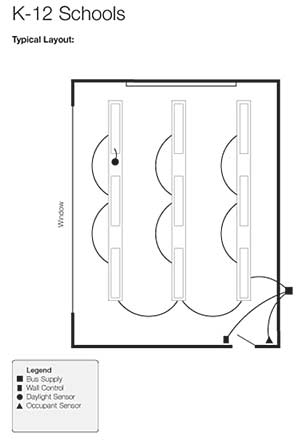Daylighting in Schools, Grades K-12
Integrated Systems Software
Integrated systems software integrates environment sensors, such as daylight and occupant sensors, with personal controls, such as wall controls and infrared remotes. With 60 percent of energy use in schools going to lighting, the combined effect of multiple environment sensors and personal controls operating together brings energy savings to spaces that previously had none. Ballasts can be flexibly programmed, instead of wired, to work individually or as a group. This eliminates the need for an area to be rewired when changes take place, creating flexibility in a space that adjusts to shifting needs. Control software reduces lighting system maintenance. All of the environment sensors and personal controls connect directly to a ballast, removing interfaces, power packs, and control devices that on other systems require more parts, programming and maintenance.
Researchers have found that physical and perceived performance of a daylight control system can differ. If the user finds the environment created by the system to be uncomfortable or disturbing in any way (abrupt on-off switching), the system is likely to be rejected or an attempt will be made to compromise it. Energy savings are therefore directly related to a system's acceptance and proper operation by the user. Hard-to-operate systems are likely to be compromised. In addition, inappropriate ambience can result in rejection of the system. View aesthetics are also an important consideration. Users often do not accept daylight without view. In addition, the quality of light is important as is the avoidance of high contrasts and absolutely uniform lighting.
|
||||||||||||||
An important but often overlooked aspect of control installations is the training of maintenance personnel and building occupants in the operation and purpose of a daylight responsive control system. Although most manufacturers provide technical support during and for a period following installation of their systems, it is easier and more economical if those managing and occupying the building can address most problems. Building and facility managers need to be aware of how to operate the system and adjust it. They need to understand the system's performance. Building occupants should receive information about the purpose of the system.
Fluorescent lighting systems are the most common daylight control lamp source because of the availability of step switching and dimming systems. HID sources are typically not a good choice for daylight switching or occupancy sensors because of the extended strike and re-strike times. There are now two-step HID sources available that may be useful in some step switching applications where the "off" mode is not desired during a typical day. A daylighting design will use both occupancy and light sensors. With these two control strategies the lights will come on only when the room is occupied and only if there is insufficient daylight. In most designs, a manual override is provided for user convenience.
Modeling Daylighting
Physical models are a very effective way to analyze daylighting performance. Even simple models can begin to inform the designer of how daylight will behave in the building. It is important that the daylight apertures be accurately modeled and that the materials used to construct the model have the designed reflectance values. The model can then be tested on the actual site or under artificial sky conditions in a daylighting laboratory. A sundial with the appropriate latitude attached to the model base allows the designer to simulate various dates and times of the year. Computer analysis is another method of testing a daylighting solution. Typically a three-dimensional digital model is constructed using computer-aided design software that is then imported into the lighting software. The programs then require the operator to define all surface characteristics, sky conditions, location, and date and time. Many of these programs can produce photorealistic renderings of the proposed design.
To make informed decisions about the technology most appropriate for a space, designers must understand the daylight characteristics of that space. The physical daylight model is one of the most fundamental and useful tools for assessing and predicting daylight levels and qualities. One method of measuring and reporting a design's performance is in terms of daylight factors. A daylight factor is the amount daylight inside a space expressed as a percent of available exterior daylight. Photocells (light sensors) and a data acquisition system are used to measure daylight factors. Up to seven photocells are placed at strategic locations within the model measure interior light levels while a reference photocell placed on the model's roof measures available daylight. The value measured at each interior photocell is divided by that at the exterior reference value to determine daylight factors. The same equipment can also be used to measure absolute illuminance levels in lux and footcandles. Daylight distribution and absolute illuminance are not solely dependent upon building properties such as geometry, glazing selection, and the finish of interior surfaces. Exterior conditions including ground reflectance and horizon obstructions such as buildings and vegetation also influence interior lighting characteristics.









